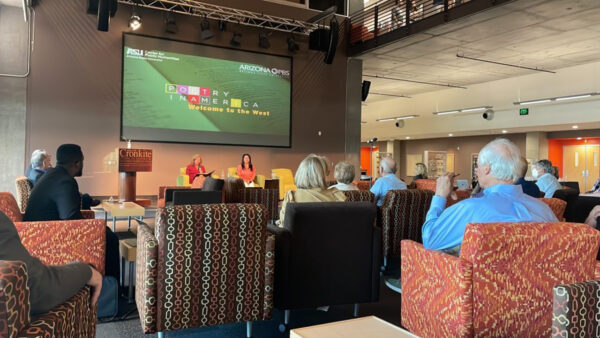NOVA “Engineering Ground Zero”
Sept. 7, 2011
EIGHT, ARIZONA PBS
–The rebirth of the World Trade Center in an incredible feat of building and innovation –
The rebirth of the World Trade Center site is one of the most affirming stories of the 21st century. Nearly a decade later, the site of the worst terrorist attack on U.S. soil is now one of the largest and most complex construction projects on the planet—and PBS' premier science series NOVA is uniquely equipped to tell the tale of engineering this icon. In a film to commemorate the tenth anniversary of 9/11, NOVA chronicles an uplifting and inherently American story of technology, innovation, and daring. Engineering Ground Zero airs Wednesday, September 7, 2011 at 8 p.m. on Eight.
With extraordinary access granted by The Port Authority of New York and New Jersey, NOVA captures the behind-the-scenes struggle of architects and engineers to make the buildings safe and highly secure under the pressures of a tight schedule, the demands of practical office space and efficient "green" architecture, and the public's expectations of a fitting site for national remembrance. The film features interviews with 1 WTC architect David Childs; Chris Ward, executive director of the Port Authority of New York and New Jersey; Mayor Michael Bloomberg, chairman of the 9/11 Memorial; Gov. George Pataki, who pushed for the construction of 1 WTC; and Michael Arad, the young architect behind the breakthrough concept for the 9/11 Memorial.
Engineering Ground Zero brings to life the story to date–profiling the men and women whose hard work and ingenuity have made the rebuilding process possible and spotlighting the pioneering science and materials that may redefine how skyscrapers are built and designed to be safer.
All of the projects are situated on only 16 acres of Lower Manhattan. The NOVA film presents a fascinating look at the difficulties as well as the inventions and innovations that come with working at the most densely concentrated urban center in the world. The world's top engineers and architects have conceived of and are now constructing the many buildings that will comprise the site–which, when completed, will form a mini-city within the City, containing four supertowers, an enormous transportation hub, and, at its heart, a memorial to the victims of the attack:
• 1 WTC – An architectural icon in the making, this bold new vision for skyscrapers will be the tallest building in North America when finished, standing at a symbolic 1776 feet. Completion is expected in late 2013.
• Santiago Calatrava's Transportation Hub – On a par with New York's Grand Central Terminal and the great rail stations of Europe, this station is located next door to 1 WTC and the 9/11 Memorial and will connect the site with the New York subway and New Jersey PATH train system as well as with the Staten Island Ferry.
• The 9/11 Memorial – This sacred structure in the shadow of 1 WTC will give the nation a place to both mourn and remember those lost on that terrible day. Built in the footprints of the original Twin Towers, it has evocative water features that constitute the largest manmade waterfalls in the world. A 2008 decision by the Port Authority to fast-track the project demanded switching to a novel top-down construction approach (rather than the traditional ground up building). Although it was a complex and untried strategy, the top-down plan allowed the Memorial to be completed two years ahead of schedule—just in time for 9/11/11.
Security is of supreme importance. The 1 WTC building has been constructed with one idea in mind: never again . A slew of specially devised features point to 1 WTC as a building that could set the new worldwide standard for skyscraper safety. It will be a castle in the sky designed to resist the malevolent forces that might seek to destroy it, either natural or man-made.
To build these magnificent buildings and combat any potential threats, architects and engineers have brought into play an arsenal of high-tech materials – using state-of-the-art high tensile and recycled steel and environmentally friendly but incredibly strong concrete and glass. The glass sheathing at 1 WTC will let the sun's rays illuminate its interior, but not let in its warmth—while protecting those behind the windows from potential blasts. Some of the concrete has been poured to the strength of 14,000 PSI (pounds per square inch)–the kind of high PSI normally used in making dams, not buildings. The massive foundations at 1 WTC have been sunk into Manhattan schist and have anchors that plunge an additional 100 feet into bedrock to further secure the building against gale-strength winds above. Additionally, the first 20 floors of the building, called the Podium, contain no offices or windows. Instead, a strong, thick concrete and steal-beamed wall surrounds a soaring lobby. This Podium section will be able to absorb and deflect any non-nuclear blast.
In the event of a catastrophe or fire, 1 WTC has been designed with state of the art redundant systems of power and water, which are contained in two concrete cores that spiral up the center of the building. Each core will contain a wide exit stairwell. In an emergency, these ample stairways will simultaneously allow rescue workers to climb up while tenants evacuate the building. The stairwells are also pressurized to keep out smoke. The designers have placed the building's air system on the roof in the event of a chemical or biological attack. At 1 WTC firefighters will also have a specially designed elevator that is pressurized to keep out smoke and allow them to quickly ascend to battle any high-rise fire.
NOVA's camera crew is there every step of the way to capture these key milestones–from the completion of the Podium level on 1 WTC to the first test of the waterfalls at the 9/11 Memorial. NOVA also travels to several cities and locations around the world–including New York, New Jersey, Minnesota, Oregon, Pennsylvania, China, and Canada—to see where and how materials are made.
Engineering Ground Zero is an inspiring look at rebuilding one of the world's most iconic places. The true story of this soaring achievement helps us not only look back and remember, but also move forward with a bold new vision for how to build skyscrapers in the 21st century.
)






















